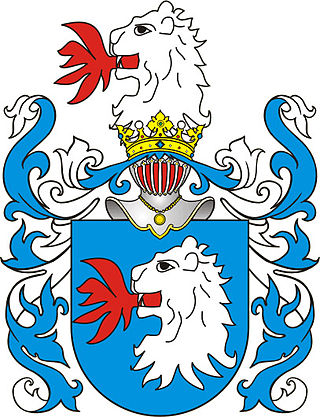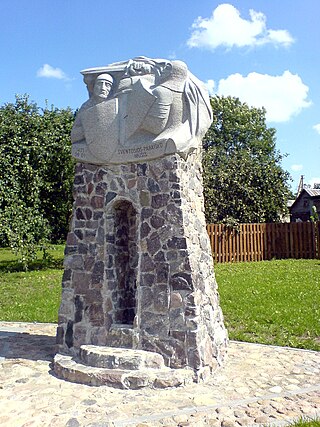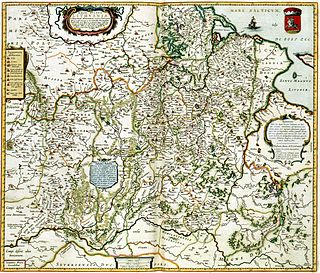Related Research Articles

The Grand Duchy of Lithuania was a European state that existed from the 13th century to 1795, when the territory was partitioned among the Russian Empire, the Kingdom of Prussia, and the Habsburg Empire of Austria. The state was founded by Lithuanians, who were at the time a polytheistic nation born from several united Baltic tribes from Aukštaitija.

The Lithuanian nobility or szlachta was historically a legally privileged hereditary elite class in the Kingdom of Lithuania and Grand Duchy of Lithuania consisting of Lithuanians from Lithuania Proper; Samogitians from Duchy of Samogitia; following Lithuania's eastward expansion into what is now Belarus, Ukraine and Russia, many ethnically Ruthenian noble families (boyars); and, later on, predominantly Baltic German families from the Duchy of Livonia and Inflanty Voivodeship. It traced its origins via Palemonids to Polemon II of Pontus.

The coat of arms of Lithuania is a mounted armoured knight holding a sword and shield, known as Vytis. Since the early 15th century, it has been Lithuania's official coat of arms and is one of the oldest European coats of arms. It is also known by other names in various languages, such as Waykimas, Pagaunė in the Lithuanian language or as Pogonia, Pogoń, Пагоня in the Polish, and Belarusian languages. Vytis is translatable as Chase, Pursuer, Knight or Horseman, similar to the Slavic vityaz. Historically – raitas senovės karžygys or in heraldry – raitas valdovas.

Švitrigaila was the Grand Duke of Lithuania from 1430 to 1432. He spent most of his life in largely unsuccessful dynastic struggles against his cousins Vytautas and Sigismund Kęstutaitis.

The Union of Horodło or Pact of Horodło was a set of three acts signed in the town of Horodło on 2 October 1413. The first act was signed by Władysław II Jagiełło, King of Poland, and Vytautas, Grand Duke of Lithuania. The second and third acts were composed by the Polish nobility (szlachta) and Lithuanian boyars, respectively. The union amended the earlier Polish–Lithuanian unions of Krewo and Vilnius–Radom. Politically, Lithuania received more autonomy as, after the death of Vytautas, the Lithuanian nobles could choose another Grand Duke instead of passing the title to Władysław II Jagiełło or his heir. However, culturally, Lithuania and Poland grew closer. Lithuania adopted Polish institutions of castellans and voivodes. Catholic Lithuanian nobles and church officials were granted equal rights with the Polish nobles and clergy. Forty-seven selected Lithuanian nobles were adopted by Polish families and granted Polish coats of arms. Thus the union signified the beginnings of the Polonization of Lithuanian culture and the rise of the Lithuanian nobility. It was one of the major steps towards the modernization and Europeanization of Lithuania.

The Union of Grodno was a series of acts of the Polish–Lithuanian union between Kingdom of Poland and Grand Duchy of Lithuania. The first acts were signed in 1432 during the Lithuanian Civil War of 1431–1435. The acts confirmed the Union of Vilnius and Radom (1401). The Union established Sigismund Kęstutaitis as the Grand Duke of Lithuania and re-established Władysław II Jagiełło's seniority and dynastic interest in Lithuania.

Jonas Gostautas or Goštautas was a Lithuanian nobleman from the Grand Duchy of Lithuania of the Gasztołd (Goštautai) noble family, a politician and skillful land owner. He served as Chancellor of Lithuania between 1443 and 1458 and was a very close advisor and mentor to Casimir IV Jagiellon before he became the third Jagiellonian King of Poland. Gostautas was not his surname, but a pagan Lithuanian given name retained after baptism by his immediate ancestor, while Jonas was his Christian name. His heirs, e.g., his sons like Martynas Goštautas, perhaps inherited the name as a surname. In 1413 at the Union of Horodło, Jonas was adopted by the Polish nobles into the Abdank clan.

Mykolas Kęsgaila Valimantaitis was a Lithuanian nobleman from Deltuva. He established the Kęsgailos family in Samogitia, where their power rivaled that of the Grand Duke of Lithuania. Mykolas Kęsgaila was the deputy of Ukmergė (1409–1412), Elder of Samogitia, and castellan of Vilnius (1443–1448). He was a father of Jonas Kęsgaila and Mykolas Kęsgaila the Younger.
The Casimir's Code was a legal code adopted in 1468 by Grand Duke of Lithuania and King of Poland Casimir IV Jagiellon with an approval of the Lithuanian Council of Lords. It was the first attempt to codify the laws of the Grand Duchy of Lithuania. The code prescribed punishment for property crimes and limited court procedures. Much of the legal system was left uncodified and was governed by customs.

Antoni Tyzenhauz was a noble from the Tyzenhaus family, son of Benedykt Tyzenhauz. As a personal friend of Stanisław August Poniatowski, the King of Poland and Grand Duke of Lithuania, Tyzenhaus became Treasurer of the Grand Duchy of Lithuania and administrator of royal estates. He began to implement various agricultural reforms and pioneered industrialization in an effort to increase productivity and economic power of the Polish–Lithuanian Commonwealth. At first, he was successful and managed to gain considerable political influence; he was considered to be the second man after the King. However, the efforts were based on the old system of serfdom and failed. Eventually, amidst increasing political rivalry with other nobles and mounting debts, Tyzenhauz was accused of fraud and removed from public offices in 1780.

The Lithuanian Tribunal was the highest appellate court for the nobility of the Grand Duchy of Lithuania. It was established by King Stephen Báthory in 1581 as the counterpart to the Crown Tribunal of the Crown of the Kingdom of Poland, established in 1578. The judges were elected from local nobles furthering nobility's Golden Liberty. The Tribunal ceased to exist after the Third Partition of Poland-Lithuania in 1795. Palace of the Lithuanian Tribunal was demolished in December 1836 – April 1837.
The Lithuanian Council of Lords was the main permanent institution of central government in the Grand Duchy of Lithuania active in its capital city of Vilnius.

The Lithuanian Civil War of 1432–1438 was a war of succession to the throne of the Grand Duchy of Lithuania, after Vytautas the Great died in 1430 without leaving an heir. The war was fought on the one side by Švitrigaila, allied with the Teutonic Knights, and on the other by Sigismund Kęstutaitis, backed by the Kingdom of Poland. The war threatened to sever the Union of Krewo, the personal union between Poland and Lithuania. Švitrigaila's alliance with the Grand Master of the Teutonic Order, Paul von Rusdorf, launched the Polish–Teutonic War (1431–1435) but failed to secure victory for Švitrigaila.
The Lithuanian Chronicles are three redactions of chronicles compiled in the Grand Duchy of Lithuania. All redactions were written in the Ruthenian language and served the needs of Lithuanian patriotism. The first edition, compiled in the 1420s, glorified Vytautas the Great and supported his side in power struggles. The second redaction, prepared in the first half of the 16th century, started the myth of Lithuanian Roman origin: it gave a fanciful genealogy of Palemon, a noble from the Roman Empire who founded the Grand Duchy. This noble origin of Lithuanians was important in cultural rivalry with the Kingdom of Poland. The third redaction, known as the Bychowiec Chronicle, elaborated even further on the legend, but also provided some useful information about the second half of the 15th century. The three redactions, the first known historical accounts produced within the Grand Duchy, gave rise to the historiography of Lithuania. All medieval historians used these accounts, that survived in over 30 known manuscripts, as basis for their publications and some of the myths created in the chronicles persisted even to the beginning of the 20th century.
The Volok Reform was a 16th-century land reform in parts of the Grand Duchy of Lithuania. The reform was started by Grand Duchess Bona Sforza in her possessions to increase the revenues of the state treasury but soon was expanded statewide and was copied by other nobles and the Church. The reform increased effectiveness of agriculture by establishing a strict three-field system for crop rotation. The land was measured, registered in a cadastre, and divided into voloks. Volok became the measurement of feudal services. The reform was a success in terms of the annual state revenue that quadrupled from 20,000 to 82,000 kopas of Lithuanian groschens. In social terms, the reform and the accompanying Third Statute of Lithuania (1588), promoted development of manorialism and fully established serfdom in Lithuania which existed until the emancipation reform of 1861. The nobility was clearly separated from the peasants which severely limited social mobility.
Kaimynas was a class of non-free peasants in the Grand Duchy of Lithuania before full-scale serfdom was established by the Wallach reform (1557). The term describes a former prisoner of war, who was allowed to live in a village and rent a piece of land from a noble. Peasants who lost their land because of debt or other circumstances could also become kaimynai.
A laukininkas was a free peasant in the early Grand Duchy of Lithuania. Laukininkai formed the majority of the Grand Duchy's population. They formed communities, called laukas. The term was later replaced by volosts and subsequently laukininkas became known as valstietis, which is a modern Lithuanian term for farmers and peasants.
The sejm was an early parliament in the Grand Duchy of Lithuania. It was active from 1445 to 1569, when it was officially abolished by the Union of Lublin. The Sejm was an irregular gathering of the Lithuanian nobility, called as needed by the Grand Duke or during an interregnum by the Lithuanian Council of Lords. The meetings would usually last one or two weeks. Sejm gradually evolved from a meeting of the most powerful magnates to a full legislative institution representing all of the nobility. The Sejm was not the main political player as it was overshadowed by the Council of Lords. The Union of Lublin created a new state, the Polish–Lithuanian Commonwealth, and joined the Sejm of Lithuania with Sejm of Poland into one Sejm of the Polish–Lithuanian Commonwealth. However, the Sejm continued to convene under the name of Lithuanian Convocation. In total there were 40 Sejm and 37 Convocations.

The history of Lithuania between 1219 and 1295 concerns the establishment and early history of the first Lithuanian state, the Grand Duchy of Lithuania. The beginning of the 13th century marks the end of the prehistory of Lithuania. From this point on the history of Lithuania is recorded in chronicles, treaties, and other written documents. In 1219, 21 Lithuanian dukes signed a peace treaty with Galicia–Volhynia. This event is widely accepted as the first proof that the Baltic tribes were uniting and consolidating. Despite continuous warfare with two Christian orders, the Livonian Order and the Teutonic Knights, the Grand Duchy of Lithuania was established and gained some control over the lands of Black Ruthenia, Polatsk, Minsk, and other territories east of modern-day Lithuania that had become weak and vulnerable after the collapse of Kievan Rus'.
References
- 1 2 Zigmas, Zinkevičius (1995). "Lietuvos Didžiosios Kunigaikštystės kanceliarinės slavų kalbos termino nusakymo problema". In Neporožnia, Nadija (ed.). Lietuva - Ukraina: istorija, politologija, kultūrologija medžiaga (in Lithuanian). Vilnius: Amžius. ISBN 5-87534-123-8.
- 1 2 3 4 5 6 7 Tarvydienė, Marytė Elena (2007). Žemėtvarkos pagrindai (in Lithuanian). Lithuanian University of Agriculture. pp. 22–24. Archived from the original (PDF) on 2011-07-22. Retrieved 2008-10-31.
- 1 2 Skardžius, Pranas (March 1973). "Donum Balticum". Aidai (in Lithuanian). 3. ISSN 0002-208X.
- ↑ Jakštas, Juozas (1984). "Lithuania to World War I". In Gerutis, Albertas (ed.). Lithuania: 700 Years. Translated by Algirdas Budreckis (6th ed.). New York: Manyland Books. p. 68. ISBN 0-87141-028-1. LCCN 75-80057.
- 1 2 Kiaupa, Zigmantas; Jūratė Kiaupienė; Albinas Kunevičius (2000) [1995]. The History of Lithuania Before 1795. Vilnius: Lithuanian Institute of History. pp. 172–174. ISBN 9986-810-13-2.
- ↑ Jonas Zinkus; et al., eds. (1985–1988). "Veldamai". Tarybų Lietuvos enciklopedija (in Lithuanian). Vol. IV. Vilnius, Lithuania: Vyriausioji enciklopedijų redakcija. p. 477.